 |
 |
|
 |
 |
Civil War Moving Panoramas
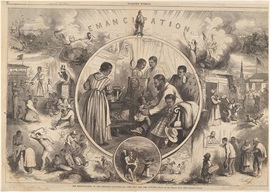 Emancipation, by Thomas Nast. This wood engraving appeared in Harper's Weekly in 1863 to commemorate the Emancipation Proclamation. Coincidentally, Nast was also a painter of moving panoramas. Courtesy of the Library of Congress.
Emancipation, by Thomas Nast. This wood engraving appeared in Harper's Weekly in 1863 to commemorate the Emancipation Proclamation. Coincidentally, Nast was also a painter of moving panoramas. Courtesy of the Library of Congress.
In September of 2021, I attended the International Panorama Council Conference (virtual) and heard a fantastic talk given by Dr. Gordon Jones of the
Atlanta History Museum. He presented on the Civil War moving panorama Andrew's Raid or the Great Locomotive Chase. His presentation inspired me to look into Civil War moving panoramas a bit more and I discovered that there
are five that have survived. The American Civil War (1861-1865) was one of the defining events of United States history, to hold the Union States together and abolish slavery. It was also the deadliest, with over one million lives lost
when the total population was only 30 million. During the Civil War, touring moving panoramas provided news and images of recent battles. Some paintings were updated with subsequent battle scenes. After the war, the paintings served both
entertainment and education for the general public. For veterans, the shows were a chance to gather and reminisce.
1865 - The Army of the Cumberland by William D.T. Travis
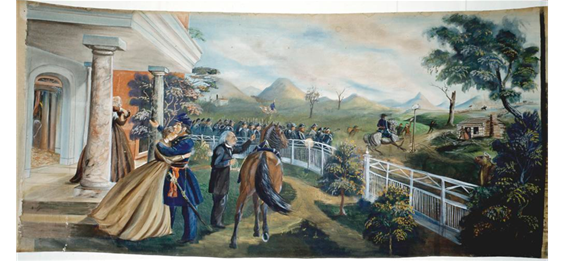 Panorama of the Union Army of the Cumberland. This is the opening scene where a soldier is saying goodbye to his family. Courtesy of National Museum of American History, Smithsonian.
Panorama of the Union Army of the Cumberland. This is the opening scene where a soldier is saying goodbye to his family. Courtesy of National Museum of American History, Smithsonian.
The Army of the Cumberland was painted in 1865 by William D.T. Travis (1838-1916). Travis had traveled with the army as a staff artist for Harper's Weekly and the Illustrated News. After the war,
he was commissioned by veterans to paint the moving panorama as a tribute to General William S. Roscrans and his army.
The painting is 8' high and 528' in length (by far longest painting of this group) and
is comprised of 32 scenes. Travis toured the midwest from 1865 - 1871 and met with considerable success.
The moving panorama resides at the National Museum of American History, at the Smithsonian Institution.
You can view all 32 scenes along with descriptions at this site.
1866 - The Myriopticon - A Historical Panorama of the Rebellion by Milton Bradley
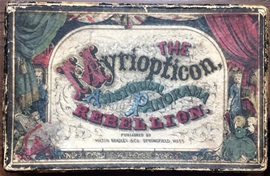 This is the top of the box that contained the toy set. Library of Congress.
This is the top of the box that contained the toy set. Library of Congress.
Milton Bradley (1836-1911) started his toy making business at the beginning of the Civil War in Springfield, Massachusetts. He drew the illustrations and wrote the script for the Myriopticon, modeling it after adult moving panorama shows of the day.
Some illustrations were similar to those that ran in Harper's Weekly, a popular source of information for the general public and panorama artists. The Myriopticon was the first in a series of five toy moving panorama sets created by Bradley.
Inside the box you would find the moving panorama viewing box containing the scroll attached to rollers. A "key" was included to crank the scroll which contained 22 scenes and was 5.5" X 15' in length. The set also included 2 preprinted tickets, an instruction
booklet/script and a broadside for advertising. When it was first sold, the price was $1.25. The latest asking price I found on eBay was $2,100.00.
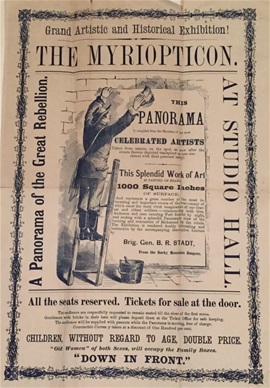 Courtesy of the NW Puppet Center, Cooks/Marks Collection, nwpuppet.org
Courtesy of the NW Puppet Center, Cooks/Marks Collection, nwpuppet.org
THE BROADSIDE was modeled after the adult moving panorama broadsides of the day. The adult posters were famous for exagerrating the length of the painting. This toy poster states "The splendid work of art is painted on nearly 1000 square
inches of surface." So, in this case, it's not much of an eggageration because 5.5" (height) X 180" (length) = 990 square inches.
At the very bottom it says " The audience will be supplied with peanuts free of charge."
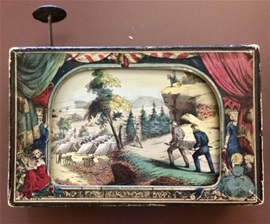 And here it is out of the box. I haven't seen a crank like that before and it may not be the original that came with the set. Library of Congress.
And here it is out of the box. I haven't seen a crank like that before and it may not be the original that came with the set. Library of Congress.
PUTTING ON A SHOW Based on suggestions from the instruction booklet, I thought I would "paint a picture" of what a Myriopticon parlor show might look like. These are some of the things a
child would do to prepare. REHEARSE - Memorize the script. Practice cranking the scroll. Recite the narrative aloud. If there was both a narrator and a crankist, then they would practice syncing the narration along
with the cranking of the scenes. Perhaps add in sound effects such as the booming of cannons or rattling of musket shot. TEST THE LIGHTING - Practice backlighting the box with a candle or oil lantern (without catching it on fire)
so that the light illuminates the scroll. Darken the room by drawing the curtains. READY THE PARLOR - Gather a small table with a table cloth for the moving panorama box. Set out chairs for the audience and on
each chair, place a little bag of peanuts. GREET THE AUDIENCE - Take their tickets and let them get settled in their chairs. Turn down the house lights and draw the curtains to darken the room. Light the candle or lantern
to illuminate the moving panorama box. Take a deep breath and the show begins!
Thank you to Western Reserve Historical Society for filming the Myriopticon and making it available for all to see! WRHS.org
1880s - Battle Scenes of the Rebellion, by Thomas Clarkson Gordon
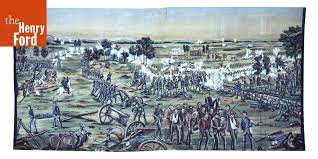 From the Collections of The Henry Ford, used with permission.
From the Collections of The Henry Ford, used with permission.
Thomas Clarkson Gordon (1841-1922) was born near Spiceland, Indiana. At the beginning of the war, he enlisted in a combat unit and served for three years. At the end of his enlistment, he returned home for a few months, then reinlisted and served
until the end of the war. After the war, he married and raised a family working as a house painter and hardwood finisher. A self-taught artist, he began painting the panorama around 1885, 20 years after the war's end. It took him two years
to paint, working on it after work and on weekends. He used the furniture factory where he worked as a studio. Gordon used oil paint on cotton sheeting. It's comprised of 15 scenes, each 7 by 15 feet that he painted separately and then stitched
together to make a vertically cranked moving panorama. He performed the moving panorama in several towns and cities in Indiana. The painting is now housed at The Henry Ford and is in storage. There is more information in the pamphlet Civil War Panorama: A Moving Panorama Painting Entitled Battle Schenes of the Rebellion by Thomas Clarson Gordon,
1841-1922. I was able to purchase a xeroxed copy on Amazon.
1885 - Andrew's Raid or the Great Locomotive Chase by Albert Ruger
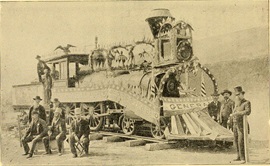 This photo was taken in the 1880s. It shows survivors of the Raid, from both Confederate and Union armies, gathered around "The General" locomotive which was decorated for the reunion. Library of Congress.
This photo was taken in the 1880s. It shows survivors of the Raid, from both Confederate and Union armies, gathered around "The General" locomotive which was decorated for the reunion. Library of Congress.
In 1862, a group of volunteer Union soldiers, led by James J. Andrews, traveled into Confederate territory and stole the locomotive called The General from Confederate troops. The mission was to drive it north, destroying the rail lines
behind them. Using the locomotive The Texan, Confederate troops gave chase for nearly 100 miles. Eventually, The General ran out of steam (literally) and the Union soldiers were captured. Some were executed, including Andrews,
but others escaped to live on and tell the tale.
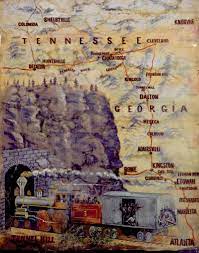 Ruger, a map maker by trade, begins the panorama with a map of the chase. Courtesy of the Ohio Historical Society.
Ruger, a map maker by trade, begins the panorama with a map of the chase. Courtesy of the Ohio Historical Society.
In 1885, William J. Knight, who had been the engineer of the The General, commissioned Albert Ruger, a friend and fellow veteran, to paint the moving panorama. It is vertically-cranked and contains 17 scenes, each 7.5'
high and 6' in width, equaling 120' in length. He used gouacheon paint on cotton muslin. Knight toured with the moving panorama for 20 years, from 1886 to 1906. The script for the first half of the show survives and is housed along with the moving
panorama at the Ohio Historical Society.
1890s - The Battle of Gettysburg by Charles H. Andrus
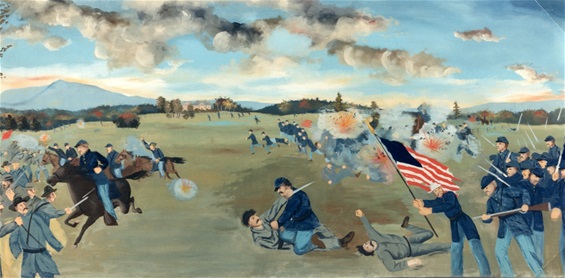 Battle of Cedar Creek, one of 10 scenes in the Battle of Gettysburg moving panorama. Courtesy of the Vermont Historical Society.
Battle of Cedar Creek, one of 10 scenes in the Battle of Gettysburg moving panorama. Courtesy of the Vermont Historical Society.
The Battle of Gettysburg was painted by Charles H. Andrus (1852-1924) who was painter of murals and theater curtains. The painting is 7' X 150' long and contains 10 scenes including the surrender at Appomattox. Also surviving
is the exhibiting apparatus with the original rollers and pine box. It is housed at the Vermont Historical Society in Barre, VT. vermonthistory.org
|
|
 |
|
|
|